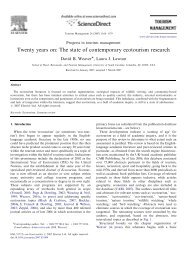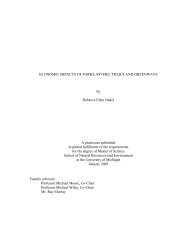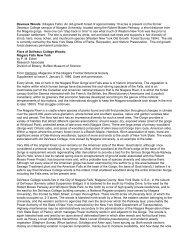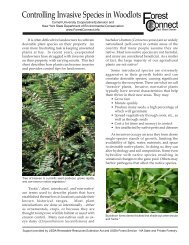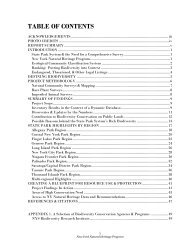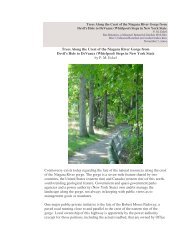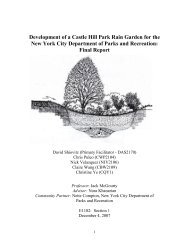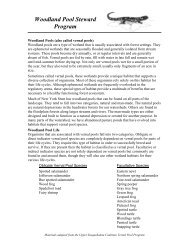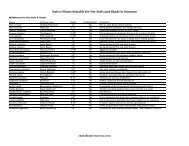Some Remarks on the Socio-Cultural Background of Restoration ...
Some Remarks on the Socio-Cultural Background of Restoration ...
Some Remarks on the Socio-Cultural Background of Restoration ...
Create successful ePaper yourself
Turn your PDF publications into a flip-book with our unique Google optimized e-Paper software.
<strong>Socio</strong>-<strong>Cultural</strong> <strong>Background</strong> <strong>of</strong> Restorati<strong>on</strong> Ecology<br />
by (nutrient) impoverishment measures such as topsoil<br />
removal or mowing without fertilizati<strong>on</strong> (Bakker 1989).<br />
However, <strong>the</strong> model is also an aes<strong>the</strong>tic <strong>on</strong>e. Any<strong>on</strong>e<br />
who is familiar with such areas is also aware <strong>of</strong> <strong>the</strong>ir<br />
importance for recreati<strong>on</strong>. Complexes <strong>of</strong> different types<br />
<strong>of</strong> calcareous grassland and clumps <strong>of</strong> woody vegetati<strong>on</strong><br />
are ideal for hiking, camping and picnicking. <str<strong>on</strong>g>Some</str<strong>on</strong>g><br />
<strong>of</strong> <strong>the</strong> landscape gardens created during <strong>the</strong> early eighteenth<br />
century are reminiscent <strong>of</strong> this situati<strong>on</strong>; here, it<br />
is remarkable that <strong>the</strong>se newly created landscapes were<br />
meant to integrate nature c<strong>on</strong>servati<strong>on</strong>, landscape architecture<br />
and social improvement in <strong>on</strong>e (Heiland<br />
1992). One example is <strong>the</strong> park <strong>of</strong> Woerlitz <strong>on</strong> <strong>the</strong> river<br />
Elbe in Central Germany, which was built in <strong>the</strong> spirit<br />
<strong>of</strong> <strong>the</strong> Enlightenment in <strong>the</strong> sec<strong>on</strong>d half <strong>of</strong> <strong>the</strong> eighteenth<br />
century. Its creators were able to combine agriculture,<br />
technical installati<strong>on</strong>s and garden design in a<br />
total artwork <strong>of</strong> usefulness and beauty.<br />
Is this a future-oriented model? It surely cannot be<br />
<strong>the</strong> reestablishment <strong>of</strong> <strong>the</strong> old infield–outfield systems<br />
with <strong>the</strong>ir associated pre-industrial land use. The simulati<strong>on</strong><br />
<strong>of</strong> such systems by corresp<strong>on</strong>ding nature c<strong>on</strong>servati<strong>on</strong>–oriented<br />
husbandry, without utilitarian interests,<br />
would <strong>on</strong>ly be suitable for small areas; it would be<br />
extremely expensive, both financially and in terms <strong>of</strong><br />
pers<strong>on</strong>nel. The soluti<strong>on</strong> could be to investigate c<strong>on</strong>temporary<br />
land use forms which combine aspects <strong>of</strong> protecti<strong>on</strong><br />
and utilizati<strong>on</strong> interests in equal measure. An example<br />
is given later in this paper.<br />
C<strong>on</strong>tradictory Goals: An Irresolvable C<strong>on</strong>flict?<br />
First, I wish to address a problem that appears time and<br />
again in restorati<strong>on</strong> projects, namely <strong>the</strong> c<strong>on</strong>tradictory<br />
nature <strong>of</strong> restorati<strong>on</strong> goals, and hence <strong>the</strong> desired target<br />
states. This is explained by <strong>the</strong> following example.<br />
Agricultural land use in sou<strong>the</strong>rn Germany leads to<br />
serious erosi<strong>on</strong> problems in <strong>the</strong> loess-covered allotments,<br />
and it becomes increasingly clear that alternatives<br />
should be developed. Several scenarios can be<br />
c<strong>on</strong>ceived (Fig. 2): (1) simply allow <strong>the</strong> area to lie fallow,<br />
so that forest cover redevelops after a period <strong>of</strong><br />
time; (2) l<strong>on</strong>g-term meadow/pasture use can be established<br />
and managed with or without deliberate nutrient<br />
impoverishment measures (mowing without fertilizati<strong>on</strong>).<br />
In this case, <strong>the</strong> goal is not <strong>on</strong>ly <strong>the</strong> cessati<strong>on</strong> <strong>of</strong><br />
erosi<strong>on</strong>, but also <strong>the</strong> establishment <strong>of</strong> a species-rich<br />
mown meadow; (3) allow <strong>the</strong> c<strong>on</strong>tinuati<strong>on</strong> <strong>of</strong> <strong>the</strong> erosi<strong>on</strong><br />
deliberately. In this case <strong>the</strong> stands <strong>of</strong> cultivated<br />
plants would <strong>the</strong>n thin out and certain rarer forb species<br />
would have a chance <strong>of</strong> survival; and (4) adapt annual<br />
crop rotati<strong>on</strong> to match <strong>the</strong> erosi<strong>on</strong> characteristics<br />
(e.g., through intermediate crop cover). If necessary,<br />
this could be combined with <strong>the</strong> establishment <strong>of</strong> landscape<br />
structures such as grassland strips and hedgerows.<br />
This would lend <strong>the</strong> landscape a certain multifuncti<strong>on</strong>al<br />
character, serving both <strong>the</strong> goals <strong>of</strong> species<br />
c<strong>on</strong>servati<strong>on</strong> as well as those <strong>of</strong> soil c<strong>on</strong>servati<strong>on</strong> and<br />
“landscape aes<strong>the</strong>tics.”<br />
Which opti<strong>on</strong> should be followed can <strong>on</strong>ly be decided<br />
<strong>on</strong> <strong>the</strong> basis <strong>of</strong> <strong>the</strong> respective situati<strong>on</strong>. The decisi<strong>on</strong> must<br />
be made not <strong>on</strong>ly according to ecological, but also to socioec<strong>on</strong>omic,<br />
criteria. The experimental farm Scheyern <strong>of</strong><br />
<strong>the</strong> Munich Research Associati<strong>on</strong> for Agricultural Research<br />
(Forschungsverbund Agraroekosysteme Muenchen <br />
FAM; Hantschel & Lenz 1993) is an example.<br />
Case Study 1: The Scheyern Experimental Farm<br />
The experimental farm Scheyern <strong>of</strong> <strong>the</strong> Munich Associati<strong>on</strong> for<br />
Agricultural Research is situated about 40 km northwest <strong>of</strong> Munich.<br />
The brown soils have been developed from loess or colluvium,<br />
or from Tertiary sands and gravels <strong>on</strong> <strong>the</strong> hilltops. Until<br />
1992 <strong>the</strong> area had been subject to widespread intensive, envir<strong>on</strong>mentally<br />
incompatible agricultural use by <strong>the</strong> Scheyern<br />
M<strong>on</strong>astery. Before being leased by <strong>the</strong> Research Associati<strong>on</strong> in<br />
1990, it was characterized by compacted soils which were subject<br />
to erosi<strong>on</strong>, a much lower than average species number and<br />
a structurally impoverished landscape (Fig. 3, left).<br />
In 1992, cultivati<strong>on</strong> was transformed (Fig. 3, right) from c<strong>on</strong>venti<strong>on</strong>al<br />
farming into an organic farming system (OF; increasing<br />
<strong>the</strong> number <strong>of</strong> crops in crop rotati<strong>on</strong>, no applicati<strong>on</strong> <strong>of</strong> pesticides<br />
and artificial fertilizers, use <strong>of</strong> wide tires <strong>on</strong> farm machines)<br />
and an integrated farming system (IF; soil management without<br />
plowing, applicati<strong>on</strong> <strong>of</strong> pesticides and fertilizers when required,<br />
crop seeding in soils covered by mulch). Areas endangered by<br />
erosi<strong>on</strong> were c<strong>on</strong>verted into fallow land or grassland; field sizes<br />
were reduced by <strong>the</strong> establishment <strong>of</strong> grassland strips or hedgerows<br />
set parallel to <strong>the</strong> altitudinal c<strong>on</strong>tours, and <strong>the</strong> incorporati<strong>on</strong><br />
<strong>of</strong> small sediment basins as material sinks. The changes that<br />
have occurred since this time have been documented as part <strong>of</strong><br />
extensive m<strong>on</strong>itoring at <strong>the</strong> intersecting points <strong>of</strong> a 50 50 m<br />
grid, supported by measurements <strong>of</strong> surface water run<strong>of</strong>f, verti-<br />
Figure 2. Restorati<strong>on</strong> alternatives for an arable field after land<br />
use transformati<strong>on</strong>.<br />
222 Restorati<strong>on</strong> Ecology JUNE 2001




